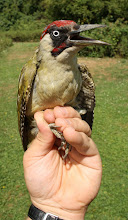You think to yourself as you watch those birds come to your feeders, well there's at least 6 blue tits (as that's how many you've seen at the same time), but probably not many more.
At least that's what my dad used to believe! I've now shown him that there are at least 61 blue tits visiting the feeders in his garden! My cold fingers took a right hammering. Especially today as 27 of 36 birds caught and ringed (including 2 retraps) were blue tits!
Totals were as follows (from 24/12/09 to 03/1/10): new (retraps)
Blue Tit 61 (2)
Dunnock 5 (1)
Robin 3
Goldfinch 7
Starling 1
Coal Tit 6
Blackbird 5
Great Tit 5
Chaffinch 3
House Sparrow 1
Greenfinch 3
Total 100 new & 3 retraps of 11 species.
One that left without a ring: Redwing (could have been 12 species). I wasn't happy as that is going to be a hard one to get again! It was a first for the location.
I was happy though that I hit 100 birds ringed over the festive period. Today I had higher numbers than on other occasions, but not so much variety. I now look forward to handing out jewellry to Bedfordshire birds after I have collected my Ivel Ringing Group rings.
Showing posts with label Cornerways. Show all posts
Showing posts with label Cornerways. Show all posts
Sunday, 3 January 2010
Tuesday, 18 August 2009
Some of my photographs
Some of my better photographs (so far) with my Canon EOS 1000D.

Above: A variety of plants in Menorca

Above: A blackbird drying itself at my dad's house (Cotswolds).

Above: The sky in Menorca

Above: Interesting pattern in the telegraph pole (Bee Eaters sat on the line)

Above: More flowers & landscape from Menorca.

Above: A variety of plants in Menorca

Above: A blackbird drying itself at my dad's house (Cotswolds).

Above: The sky in Menorca

Above: Interesting pattern in the telegraph pole (Bee Eaters sat on the line)

Above: More flowers & landscape from Menorca.
Saturday, 3 January 2009
A restaurant for birds
This 'restaurant' is exclusively for birds - but does get raided by the occasional hog (of the spikey hedge variety) during the night. Regulars to this feeding table at my dad's house are many. Here are but a few:

Above: This coal tit grabs a take away (they never eat in).

Above: Many years ago, my dad would be gardening and would be visited by Snowy - a blackbird with a few white feathers. He even got Snowy to feed from the hand. The blackbird above is not Snowy, but we presume one of several descendants. Son? Grandson? Great Grandson? Who knows, but a regular visitor none the less.
There were at least 6 different blackbirds visiting the garden (5 seen at once + the one pictured above). Across the road, between 15 and 20 blackbirds were seen (all at once) underneath 2 apple trees eating the fallen apples.

Above: A relatively new visitor to the table. This Pied Wagtail, being the first of this species (that we know of) to visit the garden, was noted by my dad for its unusual yellow face. In fact, this bird is experiencing its first ever winter and the yellow face is typical of Pied Wagtails of this age. It will, at some point this year, replace the yellow with the white found in adult birds.
Pied Wagtails are not alone in having yellow faces (while in juvenile plumage). Blue Tits and Great Tits have this too, although they have lost this feature almost entirely by the autumn.
Last year I went on a walk with my dad in the Cotswolds near his house. I saw a flock of 200 + chaffinch & some brambling & some yellowhammers & 200 + Fieldfare & Redwing all in one place. This year a walk in the same area revealed 200 + chaffinch (mostly male & including some yellowhammers). Maybe when (if) I get my C permit, I will get to ring these. Assuming that they are there next winter!

Above: This coal tit grabs a take away (they never eat in).

Above: Many years ago, my dad would be gardening and would be visited by Snowy - a blackbird with a few white feathers. He even got Snowy to feed from the hand. The blackbird above is not Snowy, but we presume one of several descendants. Son? Grandson? Great Grandson? Who knows, but a regular visitor none the less.
There were at least 6 different blackbirds visiting the garden (5 seen at once + the one pictured above). Across the road, between 15 and 20 blackbirds were seen (all at once) underneath 2 apple trees eating the fallen apples.

Above: A relatively new visitor to the table. This Pied Wagtail, being the first of this species (that we know of) to visit the garden, was noted by my dad for its unusual yellow face. In fact, this bird is experiencing its first ever winter and the yellow face is typical of Pied Wagtails of this age. It will, at some point this year, replace the yellow with the white found in adult birds.
Pied Wagtails are not alone in having yellow faces (while in juvenile plumage). Blue Tits and Great Tits have this too, although they have lost this feature almost entirely by the autumn.
Last year I went on a walk with my dad in the Cotswolds near his house. I saw a flock of 200 + chaffinch & some brambling & some yellowhammers & 200 + Fieldfare & Redwing all in one place. This year a walk in the same area revealed 200 + chaffinch (mostly male & including some yellowhammers). Maybe when (if) I get my C permit, I will get to ring these. Assuming that they are there next winter!
Subscribe to:
Posts (Atom)



